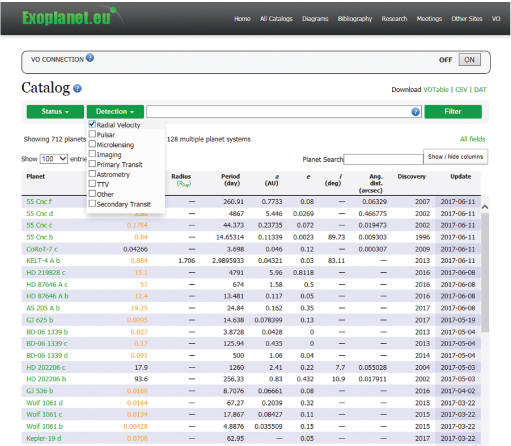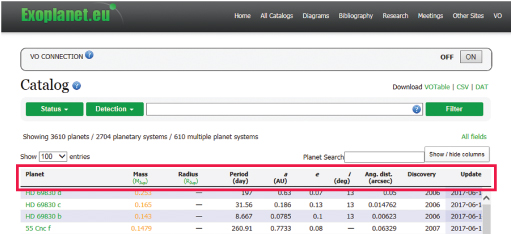5 The exoplanet collection
Since that first exoplanet, 51 Pegasi b (51 Peg b), was discovered, lots more have been found. We now know of more than 4000 planets orbiting other stars, with many more candidates in the pipeline. The candidates are objects that astronomers think are exoplanets, but which need further study for them to be sure.
Many of these planets were discovered in exactly the same way as 51 Pegasi b. For these so-called ‘radial velocity planets’, astronomers patiently looked at the spectrum of the host star night after night. This allowed them to see whether there were tiny wavelength shifts indicating a planet’s gravitational pull. However, most of the known exoplanets were first discovered using a different, more efficient, method known as the transit method. You will learn more about the transit method in the weeks to come. For now, you can explore the catalogue of exoplanets on the Extrasolar Planets Encyclopaedia at the Exoplanet.eu website [Tip: hold Ctrl and click a link to open it in a new tab. (Hide tip)] .
At the time of writing, the Exoplanets.eu catalogue lists over 4000 confirmed planets. That’s rather a lot! To make this huge catalogue easier to explore, you can perform searches for planets in particular categories. You could just look at the planets discovered using the radial velocity method, for example.
If you go onto the Exoplanet.eu website and click on the link labelled ‘All Catalogs’, you will come to the screen shown in Figure 14. If you click on the drop-down menu towards the top left labelled ‘Detection’ you can select ‘Radial Velocity’. To get the whole list you need to change the third drop-down menu from ‘Show 100 entries’ to ‘Show All entries’.
Activity 10 Exoplanet.eu database
Explore the Exoplanet.eu database. You will notice at the top of the table that there are headings such as ‘Planet’, ‘Mass’ and ‘Radius’ (Figure 15). If you want to reorder the table by any of these, just click on the heading and the table will reorder itself. To order in the opposite direction, click the same heading again.
You can search for particular planets by name by typing in the ‘Planet Search’ box.
Type 51 Peg b in the box and write down the mass and period that comes up. Notice that the mass is measured in MJ, as you saw in Week 2.
Answer
Mass = 0.47 MJ,
Period = 4.2308 days.
Did you notice anything surprising about the period of 51 Peg b?
Answer
The period is only 4.23 days: 51 Peg b’s year is only a few Earth days!


